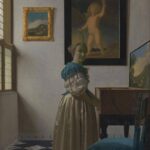Vermeer, Jan (1632-1675)
Young Woman seated at a Virginal (Zittende virginaalspeelster)
c.1672–1675
Oil on canvas, 25.5 x 20.1 cm
Private collection, New York
This entrancing picture, the only one of Vermeer’s mature works remaining in private hands, captures the quiet joy of a young woman in harmony with her music. As she gently and tenderly fingers the keyboard of her virginal, she leans slightly forward in her chair while looking out with a sympathetic expression, as though desiring to share the dulcet sounds of her instrument with the viewer. In style and execution this small masterpiece is similar to other of Johannes Vermeer’s late depictions of young women playing musical instruments, including The Guitar Player, ca. 1670, Kenwood House, London; A Young Woman Standing at a Virginal, ca. 1670–72, The National Gallery, London; and A Young Woman Seated at a Virginal, ca. 1673–75, also in The National Gallery. Aside from its comparable subject matter, this elegantly subtle painting shares with these other late works Vermeer’s sensitivity to light and his subtle rendering of flesh tones. Similarities also exist in his manner of modeling of the satin skirt, the reflective front of the virginal, the distinctive geometry of the music stand, and the radiant white wall that serves a luminous backdrop for the figure.
Much of the magic of Vermeer’s paintings arises from the visual restraint of his images, which gives them a timeless character despite the immediacy of his scenes. Here Vermeer has focused entirely on the woman and her instrument, giving the viewer no hint of the nature of the room in which she sits save the simple white wall behind her. All our attention, thus, is directed to her, and she responds in kind. This powerful human connection holds us in place. We find ourselves drawn into her world and imagining the quiet rhythms of the music she plays.
In Vermeer’s oeuvre, music making serves the purpose of courtship. Much as with Young Woman Seated at a Virginal, the viewer to whom the woman looks out assumes the role of a potential suitor. The tightly wound curls, red ribbons, and the strand of small pearls in her hair indicate that she is a young lady of proper upbringing and fine sensibility. But it is the warmth of her gaze and her welcoming smile that suggests she is a real person with emotions and feelings. In this regard Vermeer was indebted to Gerard ter Borch (1617–81) and, like Ter Borch, to the women who shared his private world.
This painting has only recently been reintegrated into Vermeer’s oeuvre after having been absent from the public’s eye for many years. Indeed, the painting was not shown in public between 1907, when it was exhibited in London, and 2001 when it was included, albeit out-of-catalogue and without an attribution, in an exhibition at the Metropolitan Museum of Art in New York. Alfred Beit, who is the first documented owner of the painting, likely purchased it in the 1890s at the recommendation of Wilhelm Bode, who was his art advisor. The attribution of the painting to Vermeer was generally accepted until the mid-1940s, but debate about the rightness of that attribution intensified in subsequent years. In 1959, Lawrence Gowing, who examined the painting shortly after it had been restored, was convinced that the attribution to Vermeer was correct. He concluded that it was “the last painting we have from Vermeer’s hand,” and was particularly struck by the distinctive rendering of “the hands, the instrument and the space and light around them.”
To try to resolve the question of attribution, Young Woman Seated at a Virginal was brought to the Rijksmuseum in 1963 where the museum’s director Arthur van Schendel and the collector/dealer Frits Lugt were able to compare it with Vermeer’s paintings in that collection. This examination is described in a letter, dated December 12, 1963, from David Carritt of Christie’s, London, to Theodore (Ted) Rousseau, chief curator of European Art at the Metropolitan Museum of Art. Van Schendel and Lugt “who had previously been slightly skeptical were completely convinced of the picture’s authenticity” after seeing the painting in person. Carritt subsequently showed the work to Philip Hendy, Director of The National Gallery, London. He describes his meeting with Hendy in a letter, dated January 20, 1964, to the painting’s then owner, Baron Frédéric Rolin: “He (Hendy) expressed the opinion that it was not only a fine example of Vermeer, but in many respects superior to the Vermeers already in the National Gallery”.
These positive assessments of the painting, however, were not widely circulated, and no mention of these opinions is found in the literature on Vermeer. In 1964, Young Woman Seated at a Virginal was returned to its owner Baron Rolin in Brussels, where it remained largely out-of-sight and unavailable to Vermeer scholars. Neither Albert Blankert nor Arthur Wheelock, who specifically questioned the appearance of the woman’s yellow shawl, accepted the attribution of this work to Vermeer in their publications from the 1970s and 1980s.
In the mid-1990s, Baron Rolin, who had, in the meantime, decided to sell Young Woman Seated at a Virginal, asked Gregory Rubenstein of Sotheby’s to determine whether a firm attribution to Vermeer could be made. Sotheby’s engaged Libby Sheldon, Catherine Hassall, and Nicola Costaras to undertake a thorough technical examination of the painting. The work was also brought in 1996 to The National Gallery, London, to be examined together with the two late Vermeer paintings in that collection. Upon viewing Young Woman Seated at a Virginal at this occasion, those present, including Arthur Wheelock and the National Gallery’s conservators, David Bomford and Ashok Roy, all felt that the three paintings were by the same hand. In 2001, when Young Woman Seated at a Virginal was lent to the exhibition Vermeer and the Delft School at the Metropolitan Museum of Art, Walter Liedtke, curator of the exhibition, added the work at the end of the installation, but as an addendum to the exhibition and without giving it an attribution. Subsequently, restorations, which removed disturbing repaint prior to and after the painting’s sale at Sotheby’s, London, in 2004, affirmed the attribution to Vermeer of Young Woman Seated at a Virginal. Since that time, the painting has been universally acknowledged as one of the last, if not the last, painting that the master executed.
The results of the technical examinations undertaken by Sheldon, Hassall, and Costaras established many similarities in the materials and techniques used in this painting and those of other late works by Vermeer. These conservators determined that the painting’s pale brown ground was applied in two layers and is identical in composition and application to the ground layers in the London paintings. Natural ultramarine (lapis lazuli) serves in the final paint layers not only to color blue motifs (as in the back of the chair) but also to lend a cool luminosity to the background plane and to the highlights on the forearms. Vermeer used a green pigment in the shadows on the face, as he did in the two works in The National Gallery in London, and in the Kenwood House painting. Finally, much as in other paintings, Vermeer created the orthogonal lines of the virginal by snapping onto the primed canvas chalked strings running to a pin stuck in the canvas at a point coincident with the woman’s shoulder.
The most dramatic information revealed by technical examinations of the painting came from X-radiography and infrared reflectography, which revealed that a fully realized garment existed under the woman’s yellow shawl. This earlier garment had a lower neckline and an intricately designed sleeve that leads gracefully from the neck to the woman’s arms. Strikingly, London modelled this underlying garment in a manner comparable to that in The Guitar Player, Kenwood House. Liedtke, who displayed Young Woman Seated at a Virginal with the Metropolitan Museum’s permanent collection in 2009, has convincingly suggested that this garment had a fur trim similar to that of the jacket of the woman playing the guitar.
Pigment analysis has also determined that the lead-tin yellow paint used to model the undergarment and yellow shawl are slightly different. V.G.M. Sivel was able to discern that the underlying garment was executed with pure lead-tin yellow paint whereas the lead-tin yellow paint used for the large yellow shawl was mixed with a quantity of organic yellow lake. He also found large particles of feldspar, presumably contaminants from Delftware production, that had settled between these two layers of paint. The distinction in the character of the lead-tin yellow paint used to model these two garments, as well as the existence of feldspar between the two layers of paint, suggests that the garments were executed a few years apart.
Whether Vermeer, himself, returned to rework the yellow garment, or whether another artist reworked the yellow garment, had long been an outstanding question. However, technical research undertaken at the Rijksmuseum, Amsterdam, in advance of the exhibition Vermeer of 2023 conclusively determined that the shawl was not painted by a later hand. According to the exhibition catalogue, the yellow shawl was “an alteration made by Vermeer himself during the painting process. In the initial design, the pleats of the satin skirt extend under the shawl, but in the final paint layers they do not continue, stopping instead at the shawl’s edge. This confirms that the shawl and skirt were elaborated at the same stage.” The exhibition catalogue concludes unequivocally that Vermeer painted Young Woman Seated at a Virginal in its entirety.
This information raises numerous questions about the dating of the painting, the reasons Vermeer decided to revise this composition, and the timing of this intervention. The connections noted above between Young Woman Seated at a Virginal and The Guitar Player (in both style of painting and character of the underlying garment) suggest that Vermeer probably began painting this work in the early 1670s. An analysis of the thread counts of the painting’s canvas by C. Richard Johnson and Don H. Johnson reinforces this dating. These researchers have determined that Vermeer painted Young Woman Seated at a Virginal on a canvas cut from the same bolt as The Lacemaker in the Musée du Louvre, Paris, which is generally dated ca. 1669–71.
The variance in approach between the underlying and final versions of the yellow shawl, however, is quite substantial and suggest that some time passed before Vermeer revised the garment. The broad, sweeping folds, with their sharp, unmodulated edges, are quite different from Vermeer’s more nuanced manner of painting in the early 1670s, as seen, for example, in the yellow jacket in Vermeer’s The Guitar Player. It was largely because of the distinctive executions of this shawl that the attribution to the artist, or at least of the yellow shawl, has been contested in the past. The closest comparison to the expressive character of this yellow shawl is the modelling of the blue dress in A Young Woman Seated at a Virginal in the National Gallery, London, which, for stylistic reasons, likely dates around 1673–75. In both works one finds broad sweeping folds with little modulation between the highlights on their ridges and the shadowed pockets between them. It is thus likely that Vermeer returned to the Leiden Collection’s Young Woman Seated at a Virginal at about this time to replace the underlying yellow garment with the yellow shawl.
Vermeer probably made this revision to update the woman’s clothing so that it would be compatible with the more flowing style of dress fashionable in the mid-1670s. Ermine-bordered yellow jackets, such as the one seen in The Guitar Player, went out of favor after 1672, the devastating Rampjaar (Disaster Year) when French and Germans forces invaded The Netherlands. The flowing shawl gave the young woman a more timeless, classical look than evident in her previous mode of dress. Although the hostilities during the Rampjaar negatively affected the art market, it seems unlikely that Vermeer stopped painting in 1672, as some have postulated. Indeed, after Vermeer’s death in December 1675, the artist’s widow, Catharina Bolnes (ca. 1631–87), lamented that he had “been able to earn very little or hardly anything at all” because of the war with the King of France. At his death Vermeer left “ten painter’s canvases” among the supplies in his studio, another indication that he was still active as a painter. Much as Gowing postulated, Vermeer likely made his revisions to Young Woman Seated at a Virginal during the last year of his life. Whether he did so on his own initiative or because of a patron’s request is a fascinating question that, tantalizingly, remains open.
– Walter A. Liedtke, Arthur K. Wheelock Jr., 2017; revised by Arthur K. Wheelock Jr., 2023. (The Leiden Collection)
Compare:
 Vermeer, Jan (1632-1675)
Vermeer, Jan (1632-1675)
A Young Woman Seated at a Virginal
c.1670–1672
National Gallery, London
 Vermeer, Jan (1632-1675)
Vermeer, Jan (1632-1675)
A Young Woman Standing at a Virginal
c.1670–1672
National Gallery, London
 Vermeer, Jan (1632-1675)
Vermeer, Jan (1632-1675)
The Guitar Player
c.1672
Kenwood House, London
